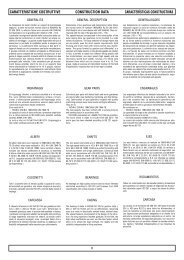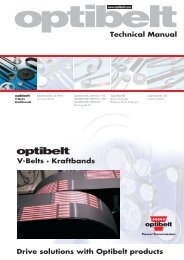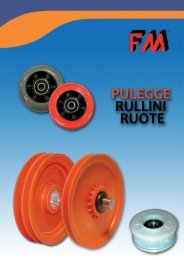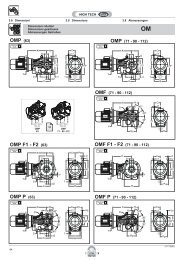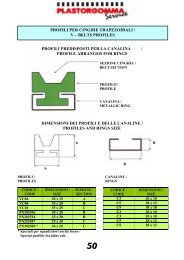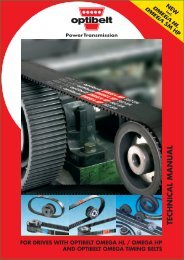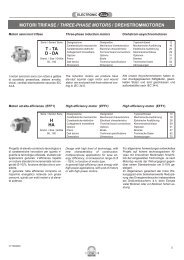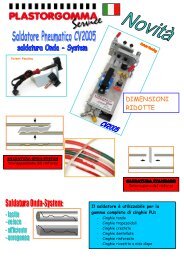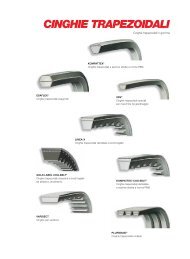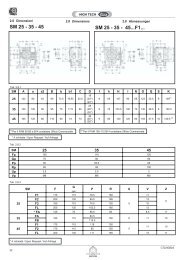Technical Manual for Ribbed Belt Drives
Technical Manual for Ribbed Belt Drives
Technical Manual for Ribbed Belt Drives
- No tags were found...
You also want an ePaper? Increase the reach of your titles
YUMPU automatically turns print PDFs into web optimized ePapers that Google loves.
Design Hints<strong>Ribbed</strong> <strong>Belt</strong> TensionThe correct level of belt tension is of extreme importance <strong>for</strong> troublefree transmission of power, and <strong>for</strong> the achievement of acceptablebelt service life. Often, tension which is either too high or too lowresults in early belt failure. A belt which is over tensioned sometimescauses bearing failure.It has been shown that the more common tensioning instructions -e. g. using the “thumb pressure deflection method” - do not resultin tension being obtained which would enable drives to beoperated at optimum efficiency. It is there<strong>for</strong>e recommended thatthe required static belt tension “T” be calculated individually <strong>for</strong>every drive using the following Optibelt <strong>for</strong>mulae. The best initialtension is the absolute minimum <strong>for</strong> a drive which permits thehighest level of power transmission under consideration of thenormal slip.Once the ribbed belt has been fitted, the tension should bechecked, using our tension gauge.The belt should be observed regularly during the first few hours ofservice. Experience indicates that the first retensioning should beundertaken after approximately 0.5 to 4 hours full load running.The initial belt stretch is then taken up.After approximately 24 hours running, especially if the belt has notrun continuously under full load conditions, the drive should bechecked and, if necessary, retensioned. The checking intervals canthen be increased considerably to several hundred or thousandoperating hours, and the tension adjusted when necessary. Inaddition, our basic fitting and service instructions should beobserved.Over or undertensioning of the drive will be avoided if the belttension is calculated, set or checked by one of the followingmethods:I. Checking the <strong>Belt</strong> Tension by Span DeflectionThis method provides an indirect measurement of the calculatedor actual static belt tensionE = <strong>Belt</strong> deflection per 100 mm span length(mm)E a = <strong>Belt</strong> deflection <strong>for</strong> a given span length(mm)f = Load per rib used to set belt tension (N)k = Constant <strong>for</strong> calculation of centrifugal <strong>for</strong>ceL = Drive span length (mm)S a = Static shaft loading(N)T = Static belt tension per rib (N)1. Calculate the static belt tension using the following <strong>for</strong>mula:500 · (2.03 – cT ≈ 1 ) · P B+ k · v 2c 1 · z · vThe drive should initially be tensioned to a maximum of 1.3 xT (initial tensioning).2. Determine E - the deflection per 100 mm length - from the belttension deflection characteristics as given in diagram 2 page 41.3. Calculate E a -the deflection <strong>for</strong> a given span length- <strong>for</strong> the actualdrive span length L.E aL≈E · L100= C nom · sinβ2Apply the load to set belt tension f*, using the value fromDiagram 2 <strong>for</strong> the appropriate belt section, to the centre of, andat right angles to, the span, as shown in the figure below.Measure the deflection and if necessary adjust the centres untilthe correct belt tension is achieved.* When choosing the load to set belt tension the number of ribsmust be taken into consideration.span40



